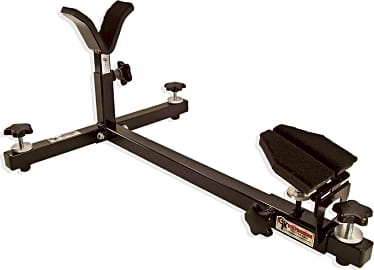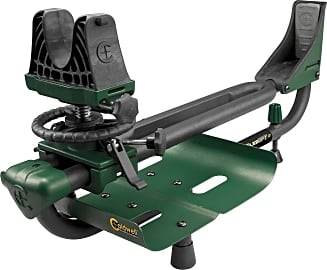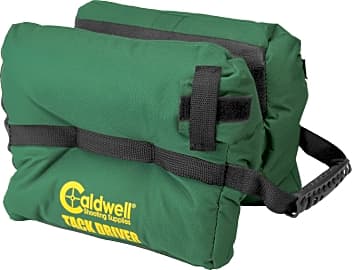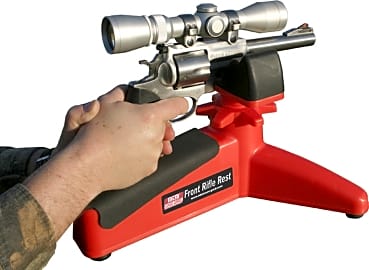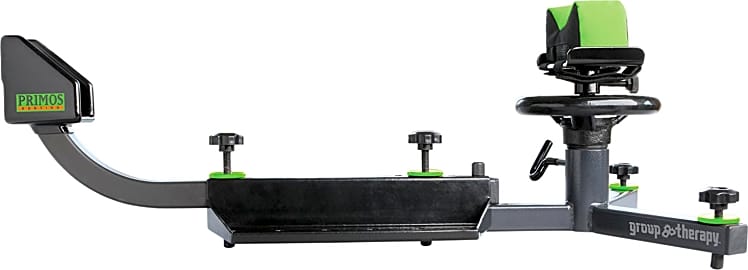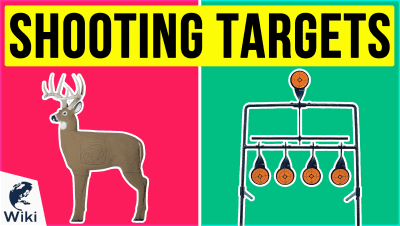The 10 Best Shooting Rests

This wiki has been updated 35 times since it was first published in December of 2016. There is no better way to sight in a rifle than by using a stable shooting rest. These devices minimize recoil and allow for minute adjustments that can nearly eliminate the errors invariably made when a firearm is supported by an unassisted shooter. Many help with safer, more accurate use of handguns as well, while also being small enough to easily transport to the range or even out in the field. When users buy our independently chosen editorial recommendations, we may earn commissions to help fund the Wiki.
Editor's Notes
March 15, 2021:
There's a pretty significant variety of shooting rests out there, but overall, we really like the BOG FieldPod, formerly from Caldwell, because of its premium craftsmanship and adjustability, as well as the high-end Magnum and ChairPod variants. Those who appreciate minimalist equipment built in the USA - which applies to qutie a few hunters - will love the CTK Precision P3 Ultimate. There's not much to it, but it's about as stable as they get. Speaking of minimalism, the Bog-Pod Rapid is an excellent choice if you plan on tracking your prey a long distance, thanks to its dependability, compact sizer, and light weight. Alternatively, the Caldwell Lead Sled DFT 2 is a relatively complex model that offers a god level of fine adjustment.
Also, for what it's worth, we continue to like the variety of offerings here, and so have left our rankings unchanged in the most recent update.
June 21, 2019:
For these rankings, we included models that were easily portable, like the Caldwell DeadShot FieldPod, as well as more stationary models best-suited for range use, such as the Caldwell Lead Sled DFT 2. The former outranked the latter by a few spots, largely due to the fact that you can take it in the field with you. However, if you're only concerned with dialing in your scope or taking target practice, a heavy, stationary model like the Lead Sled should be your first choice.
Before making your purchase, decide what you're going to be firing from your new bench rest, as not all models are capable of universal compatibility. For example, the Primos Group Therapy Bench Anchor was created in such a way that a 30-round magazine will interfere with the rest, throwing off your shot. This may not be an issue for you at all, but perform your due diligence before you put your money down.
Look at the pictures and our descriptions to get an idea of the layout as well. Some will be laid out in a way that's easier for you to adjust on the fly, while others will be awkward and cumbersome, and may require you to set your rifle down — which will get annoying fast. The placement of the adjustment dials and knobs is one of the most critical factors in a rest's suitability, so don't skimp on this aspect of the buying process.
Special Honors
Seb NEO One of the smoothest joystick rests you'll find anywhere, the NEO allows you to track moving objects without jerking or jumping all over the place. The adjustable-width front bag is a nice touch, too, especially for shooters with plenty of different rifles to choose from (and isn't that all shooters?). sebrests.com
Ransom Rifle Master This model is nearly endlessly customizable, as it has multiple bag plate options, quick-change adapters, and an optional windage adjustment bag plate. It's made from a special alloy designed to minimize vibrations to boot. ransomrest.com
Kopfjager Industries Reaper Grip This tripod-mounted option has a special clamp design that allows it to contour fully to the stock of your rifle, offering incredible stability. It's easy to lock with your non-dominant hand without accidentally losing your position. kopfjagerindustries.com
The Three Main Types Of Shooting Rests
If live game hunting in the field, however, you may find lead sleds to be more of a hindrance than a help.
When it comes to shooting rests, you have three main styles to choose from: lead sleds, shooting bags, and front rifle rests. Each shooter will find a different type of shooting rest that best compliments their shooting style. Some shooters may find that a certain type of rest is ideal for hunting game, but use an entirely different style when practicing on the range with non-moving targets.
Lead sleds are one of the best options for reducing the possibility of human error when firing. Lead sleds are designed to completely contain a rifle. This ensures the rifle stays stable throughout the entire aiming and firing process. It also significantly lessens the recoil force the shooter feels. Lead sleds are ideal when using a scope and shooting at stationary targets, especially those far down range. The ability to make minute windage and elevation adjustments makes it is easy to hone in on a target after a couple of test shots. If live game hunting in the field, however, you may find lead sleds to be more of a hindrance than a help. Their size and weight makes them a hassle to carry on long treks. It is also difficult to make split second aim adjustments on a lead sled, since you have to fumble around with fingertip controls rather than just slightly lifting or lowering the butt of your rival.
Shooting bags are a great, relatively lightweight and compact option, making them ideal for field use. They come in a variety of sizes, materials, and styles. Depending on the style, a shooter may place a shooting bag under the butt of the rifle, under the barrel, or under their arm. You can attach many butt and barrel models directly to your gun or just toss them on the nearest surface and place your gun against them when it is time to shoot. Shooting bags aid in rifle stability and help to absorb some recoil force. Because shooting bags don't require much set up, and they only support one area of your gun, they allow you to easily adjust your aim and track moving targets.
Front rifle rests are sort of like a combination of the previous two types. They are comprised of a small stand and a bag-style barrel rest. Front rifle rests are smaller than full led sleds, but still provide a good amount of stability and recoil reduction. They will generally allow the shooter to make slight elevation and windage adjustments via the use of finger screws. Since front rifle rests don't hold the butt of the gun, it is easier to get on target and make aim adjustments more quickly than with a lead sled.
The Benefits Of Using A Shooting Rest While Hunting
Whether you choose to go with a shooting pod or shooting rest, having some type of rifle-stabilizing device offers a number of benefits to hunters. While some people view hunting as a politically incorrect and savage sport, hunters know this isn't true. It is easy to see the hypocrisy in someone who eats meat judging a person for hunting, especially considering the horrid conditions cattle and other animals in the meat industry endure. All true hunters know it is their ethical responsibility to make a good clean shot that results in a quick kill with little to no suffering. A good quality shooting rest can often mean the difference between making that shot and botching it.
Shooting rests provide shooters with a sense of stability that is almost impossible to achieve in unaided shooting. It is not uncommon for hunters to experience a surge of adrenaline when a large twelve-point buck makes an appearance. This adrenaline can easily result in shaky hands. Using a shooting rest ensures that the rifle will be steady, no matter how much the shooter's hands are trembling from excitement and adrenaline.
If sitting in the brush waiting a long time for a turkey or deer to make an appearance, a shooting rest allows you to keep the rifle set in a horizontal, ready-to-shoot position, without a lot of strain on the body. Keeping a gun in a ready-to-shoot position minimizes movement when the animal appears, reducing your chance of scaring it off and improving your odds of making a clean shot.
A Brief History Of Shooting As A Sport
Shooting isn't only done for hunting. Shooting for sport has a long history, as well. Historians have found mention of shooting for sport, rather than military pursuits, as far back as the 8th century B.C.E. Early sport shooters used bows and arrows, instead of guns, but the basic principle was the same — proving who had the most skill and could make the most accurate shots. Ancient Greeks, Indians, and Persians held archery contests to honor the gods.
Ancient Greeks, Indians, and Persians held archery contests to honor the gods.
Germanic people formed the first official shooting clubs that made use of firearms in either the 13th or 14th century. Competitions of the time were festive events where participants would shoot at ornately painted targets. Competitors and club members in these early competitions used either matchlock or flintlock rifles. In 1871, Civil War Colonel William C. Church and General George Wingate formed the National Rifle Association, which is today most commonly referred to as just the NRA. They were motivated to promote shooting as a sport because of the large amount of poor marksmanship they noticed during the civil war.
In 1872, the NRA established their first official shooting range on Creed Farm in Long Island. During the early 1900s, the NRA went on to found number of shooting clubs at colleges and universities across the nation. These clubs proved to be extremely popular, and it wasn't long before thousands of people were regularly practicing the art of shooting. These days, there are countless ranges scattered all across America.


